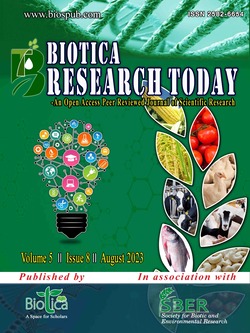
Impacts and Management Strategies of Parthenium hysterophorus L. in Agriculture
R. Sathya Priya*
Dept. of Agronomy, Tamil Nadu Agricultural University, Coimbatore, Tamil Nadu (641 003), India
N. Jagathjothi
Dept. of Agronomy, Tamil Nadu Agricultural University, Coimbatore, Tamil Nadu (641 003), India
M. Kathiravan
Agricultural College and Research Institute, Vazhavachanur, Tamil Nadu Agricultural University, Coimbatore, Tamil Nadu (606 753), India
M. Yuvaraj
Agricultural College and Research Institute, Vazhavachanur, Tamil Nadu Agricultural University, Coimbatore, Tamil Nadu (606 753), India
Jaiby Cyriac
Dept. of Botany, Newman College, Thodupuzha, Kerala (685 585), India
DOI: NIL
Keywords: Allelopathy, Biodiversity loss, Health hazards, Herbicide management
Abstract
Parthenium hysterophorus may have migrated to India in 1910 on germplasm from diseased cereals, but it wasn't discovered until 1956. Since its discovery in 1955, weed has spread to about 42 million acres of land. The individual weed can yield 10,000 to 15,000 viable seeds due to its extraordinary fecundity. Four weeks after germination, plants are ready to blossom and produce seeds. This important global weed is also a significant risk to biodiversity and causes crucial health problems for humans and animals, including dermatitis, asthma and bronchitis. Chemical control must be managed appropriately. When plants are young and haven't set seed, weed should be pulled. However, merely limiting its expansion is not enough to get rid of it; instead, it can be managed through utilizing it for different purpose.
Downloads
not found
Reference
Javaid, A., Shah, M.B.M., 2008. Use of Parthenium weed as green manure for maize and mungbean production. Philippine Agricultural Scientist 91(4), 478-482.
Kumari, P., Sahu, P.K., Soni, M.Y., Awasthi, P., 2014. Impact of Parthenium hysterophorus L. invasion on species diversity of cultivated fields of Bilaspur (C.G.) India. Agricultural Sciences 5(8), 754-764. DOI: https://doi.org/10.4236/as.2014.58079.
Lakshmi, C., Srinivas, C.R., 2007. Parthenium: A wide angle view. Indian Journal of Dermatology, Venereology and Leprology 73(5), 296-306. DOI: https://doi.org/10.4103/0378-6323.35732.
Lalita, Kumar, A., 2018. Review on a weed Parthenium hysterophorus (L.). International Journal of Current Research and Review 10(17), 23-32. DOI: https://doi.org/10.31782/IJCRR.2018.10175.
